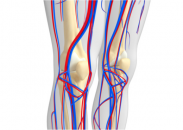5 years ago, several prospective randomized studies confirmed paclitaxel coated balloons were safe and effective in femoropopliteal territory. However, a recently published meta-analysis of heterogeneous studies including both paclitaxel coated balloons and drug eluting stents has linked these devices to mortality. In addition, higher doses were associated to higher mortality, both at 2 and 5…
EuroPCR 2019 | EFFPAC: New Peripheral Paclitaxel Coated Balloons, Efficacy with no Sign of Mortality
Paclitaxel coated balloons in peripheral territory have been under the spotlight for alleged increased mortality, which even though not observed in this study, experts insist, calls for new studies with enough statistical power. Compared against plain balloon angioplasty, paclitaxel coated balloons resulted in improved patency and less revascularization at 24 months in superficial or popliteal…
Drug-Eluting Stents vs. Balloons While Paclitaxel Is in the Eye of the Storm
Even after the US Food and Drug Administration (FDA) issued an alert on paclitaxel devices in patients with femoropopliteal artery disease, which caused the interruption of a few ongoing studies, reality indicates that the efficacy of these devices has been proven and that they are still used. The increased mortality observed in the meta-analysis that…
FDA Alert on Drug-Coated Balloons and Stents in Femoropopliteal Artery Disease
The US Food and Drug Administration (FDA) has issued an alert on the potential long-term risk of paclitaxel-coated balloons and paclitaxel-eluting stents in patients with femoropopliteal artery disease. This agency is evaluating signals of increased long-term deaths among patients with femoral or popliteal artery disease treated with paclitaxel-coated devices in a recent study. In…
Long Term Effect of Low Dose Paclitaxel Coated Balloon
The beneficial effect of low dose drug coated balloons with paclitaxel is sustained in time according to this randomized study. In a nutshell, this study has shown a significant statistical difference in favor of paclitaxel coated balloons vs. conventional PCI at 2 years. The safety and efficacy of new generation low dose drug coated balloons…
Infrainguinal Bypass Following Failed Endovascular Intervention Has a Different Outcome
We often inform our patients we should first approach the superficial femoral with an endovascular intervention, and that should it fail or develop restenosis, we could always resort to a bypass. We were not lying when we’d assume a bypass following endovascular intervention would have the same outcome as a primary bypass. Simply put, no…
TCT 2018 | IMPERIAL: First Study Comparing Drug-Eluting Stents in Patients with Femoropopliteal Disease
The IMPERIAL trial compared the safety and efficacy of a nitinol self-expanding polymer-free placlitaxel-eluting stent (Zilver PTX, Cook Medical, already approved by the US Food and Drug Administration [FDA]) and a nitinol self-expanding polymer-coating placlitaxel-eluting stent (Eluvia, Boston Scientific). This was a single-blind randomized trial in patients with symptomatic intermittent claudication (Rutherford categories 2, 3, or…
Frailty: What Happens When We Are Too Late in Critical Lower Limb Ischemia
This condition, now “trending” among patients undergoing transcatheter aortic valve replacement (TAVR), has expanded to almost all patients we treat, always with the same outcome: the prognosis is bad, so bad that it might warrant making the difficult decision of not going forward. The association between frailty and bad prognosis is easy to see and…
HIV and Peripheral Artery Disease: Acknowledging the Association
The role of human immunodeficiency virus (HIV) in the development of vascular disease (specifically peripheral artery disease) remains unclear. Is the virus per se the direct cause of this disease or is it a consequence of dyslipidemia, one of the adverse effects of antiretrovirals? This study looked into the effect of HIV infection on peripheral…
Mortality in Peripheral Vascular Disease Drops Due to Revascularization
This cohort study shows that, from 2006 to 2015, the overall survival rate increased and the risk of major amputation decreased following lower limb revascularization. These population observations indicate that outcomes after lower limb revascularization have improved during the assessed period, and so have the centralization and specialization of interventional services. The availability and diversity…
What’s New in the European Guidelines on Peripheral Arterial Disease
Since the last version of the European guidelines on the diagnosis and treatment of peripheral arterial disease in 2011, there have been many trials and registries that warrant guideline adjustments in many aspects. The first novelty is the teamwork that gave way to these guidelines, which were written in collaboration with the European Society of…









